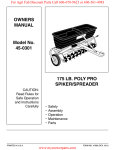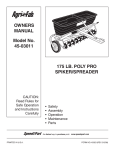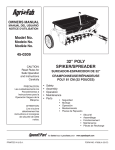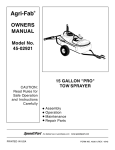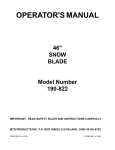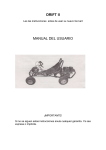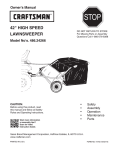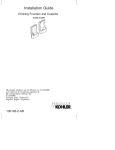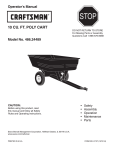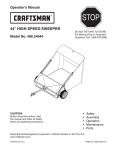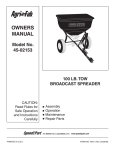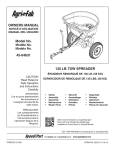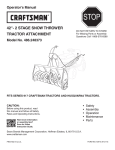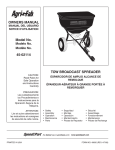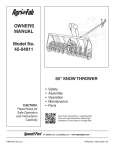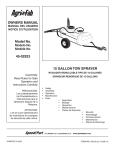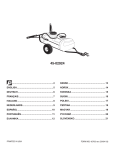Download 32" POLY SPIKER/SPREADER Model No. 45-0309-062 - Agri-Fab
Transcript
OWNERS MANUAL MANUAL DEL USUARIO Model No. Modelo No. 45-0309-062 32" POLY SPIKER/SPREADER SURCADOR-ESPARCIDOR DE 32” CAUTION: Read Rules for Safe Operation and Instructions Carefully • • • • • Safety Assembly Operation Maintenance Parts PRECAUCION: Lea cuidadosamente los Porcedimientos e Instrucciones para la Operación Segura de la Máquina. • • • • • Seguridad Montaje Operación Mantenimiento Piezas de Repuesto Call 1-800-448-9282 for missing parts or assembly help. PRINTED IN U.S.A. FORM NO. 42172 rev. (6/22/11) RULES FOR SAFE OPERATIONS Any power equipment can cause injury if operated improperly or if the user does not understand how to operate the equipment. Exercise caution at all times, when using power equipment. • Wear eye and hand protection when handling and using lawn chemicals. • Always begin with the transmission in first (low) gear and gradually increase speed as conditions permit. Maximum towing speed - 10 M.P.H. • Do not drive too close to a creek or ditch and be alert for holes and other hazards which could cause you to loose control of the tractor and spiker/spreader. • Before operating the vehicle on any grade (hill) refer to the safety rules in the vehicle owner's manual concerning safe operation on slopes. Stay off steep slopes! • Follow maintenance and lubrication instructions as outlined in this manual. • Read this owner's manual before attempting to assemble or operate the spiker/spreader. • Read the towing vehicle owner's manual and know how to operate the tractor before using the spiker/spreader attachment. • Do not allow anyone to ride on or sit on the spiker/ spreader. • Never allow children to operate the tractor or spiker/ spreader attachment. • Do not allow adults to operate the tractor or spiker/ spreader without proper instructions. • Read the chemical label for instructions and cautions for handling and applying chemicals. Look for this symbol to point out important safety precautions. It means – Attention!! Become alert!! Your safety is involved. CARTON CONTENTS 1. 2. 3. 4. 5. 6. 7. 8. Chain Cover Flow Control Lever Center Brace Hopper Assembly Hitch Tube (2) Lift Handle Spike Disk (7) Drive Disk Assembly (2) 2 9. Wheel (2) 10.Transport Tube Assembly 11. Hitch Bracket (2) 12. Spiker Shaft Assembly 4 3 1 5 10 6 7 9 11 8 2 12 SHOWN FULL SIZE A C B D E H G F I Q P V U R K T L J M S W N O NOT SHOWN FULL SIZE X Z Y HH EE CC II AA FF GG DD BB JJ HARDWARE CHART REF. PART NO. QTY A B C D E F G H I J K L M N O P Q R 45100 43224 44180 43084 43085 43063 1509-90 43012 44215 44731 43178 47189 47810 43019 48115 43088 1543-69 43081 2 3 2 2 2 1 1 1 1 2 1 5 10 2 2 2 2 4 DESCRIPTION Hex Bolt, 1/2" x 4" Full Thread Hex Bolt, 5/16" x 2-1/4" Hex Bolt, 5/16" x 2" Hex Bolt, 5/16" x 1-3/4" Hex Bolt, 5/16" x 1-1/2" Hex Bolt, 5/16" x 1" Hex Bolt, 1/4-20 x 1-1/4" Hex Bolt, 1/4-20 x 3/4" Carriage Bolt, 5/16" x 1-3/4" Self Tapping Screw, 1/4" x 1/2" Hex Nut, 1/4" Nylock Hex Nut, 1/4" Nylock Hex Nut, 5/16" Jam Nut, 1/2" Nylock Jam Nut, 1/2" Flat Washer, 1/4" Nylon Washer, 21/64" Flat Washer, 5/16" REF. PART NO. QTY S T U V W X Y Z AA BB CC DD EE FF GG HH II JJ 3 R19171616 R19212016 43093 44101 43343 47960 741-0249 47777 23520 46497 46524 47959 47969 43848 43943 712-0421 47623 47962 4 10 3 1 1 1 13 1 1 2 5 1 1 1 1 1 1 1 DESCRIPTION Flat Washer, 1/2" Flat Washer, 5/8" Cotter Pin, 1/8" x 1-1/2" Cotter Pin, 3/32" x 3/4" Hair Cotter Pin, 1/8" Chain with Connecting Link Flanged Bearing Compression Spring 1/4" Thick Spacer Short Spacer Tube Long Spacer Tube Flow Control Link Ferrule Control Lever Grip Height Adjustment Grip Plastic Wing Nut Flat Head Hitch, Pin, 3/8" Flow Plate Spring ENGLISH ASSEMBLY 4. Assemble the grip onto the lift handle. See figure 2. 5. On the right side, insert a 5/16" x 1-3/4" hex bolt through a 5/16" flat washer and then through the rear hole in the hopper and the hitch tube. Assemble the transport tube and then the lift handle onto the bolt and secure with a 5/16" nylock hex nut. Do not tighten yet. See figure 2. 6. Assemble a 5/16" x 1" hex bolt and 5/16" nylock hex nut to the bottom hole in the transport tube assembly and the lift handle. Tighten. See figure 2. TOOLS REQUIRED FOR ASSEMBLY (2) 7/16" Wrenches (2) 1/2" Wrenches (2)3/4" or Adjustable Wrenches (1) Screwdriver (1) Pliers (GG) GRIP LIFT HANDLE (R) 5/16" FLAT WASHER (D) 5/16" x 1-3/4" HEX BOLT Spike points are sharp. Exercise caution when handling and working near spike disks. (F) 5/16" x 1" HEX BOLT 1. Remove the hardware pack and all individual parts from the carton. Lay out as shown on pages 2 and 3. 2. Attach a hitch tube to the front hole in the right hand side of the hopper using a 5/16" x 1-1/2" hex bolt, a 5/16" flat washer and a 5/16" nylock hex nut. Assemble the bolt and washer from inside the hopper. Do not tighten yet. See figure 1. (M) 5/16" NYLOCK HEX NUT 3. Repeat on the left hand side of the hopper. TRANSPORT TUBE FIGURE 2 VIEWED FROM FRONT RIGHT CORNER 7. On the left side, insert a 5/16" x 1-3/4" hex bolt through a 5/16" flat washer and then through the rear hole in the hopper and the hitch tube. Assemble the transport tube onto the bolt and secure it with a 5/16" nylock hex nut. Do not tighten yet. See figure 3. (E) 5/16" 1-1/2" (R) 5/16" FLAT HEX BOLT WASHER VIEWED FROM FRONT LEFT CORNER (D) 5/16" x 1-3/4" HEX BOLT HITCH TUBE (M) 5/16" NYLOCK HEX NUT FIGURE 1 FIGURE 3 4 (R) 5/16" FLAT WASHER (M) 5/16" NYLOCK HEX NUT ENGLISH 8. Fasten the hitch tubes together using three 5/16" x 2-1/4" hex bolts and 5/16" nylock hex nuts. Do not tighten yet. See figure 4. 14.If the wheel does not spin freely, back off the nylock jam nut and then the plain jam nut 1/4 to 1/2 turn each. 15.Assemble a wheel to the other side. See figure 6. TRANSPORT TUBE (M) 5/16" NYLOCK HEX NUT (3) (S) 1/2" FLAT WASHER (B) 5/16" x 2-1/4" HEX BOLT (3) (O) 1/2" NYLOCK JAM NUT FIGURE 4 (A) 1/2" x 4" HEX BOLT (N) 1/2" HEX JAM NUT FIGURE 6 9. Assemble the hitch brackets to the hitch tubes using two 5/16" x 2" hex bolts and 5/16" nylock hex nuts. Do not tighten. See figure 5. 10.Assemble the hitch pin through the hitch brackets and secure with the hair cotter pin. See figure 5. IMPORTANT: Do not collapse the flat ends of the hitch tubes when tightening the bolts in the next step. 11.Tighten, but do not overtighten the two 5/16" x 1-1/2" hex bolts assembled in steps 2 and 3. Tighten, but do not overtighten the two 5/16" x 1-3/4" hex bolts assembled in steps 5 and 7. The lift handle must be able to pivot. Tighten the hex bolts assembled in steps 8 and 9. 16.Screw a 1/4" hex nut all the way onto the flow control link. Assemble the ferrule onto the link and then start a 1/4" nylock hex nut one or two turns onto the link. See figure 7. 17.Assemble the ferrule into the hole at the end of the flow control lever using a 1/4" nylock hex nut. Tighten the nut, leaving it loose enough that the ferrule can pivot. See figure 7. 18.Assemble the grip onto the end of the flow control lever. See figure 7. (FF) GRIP (C) 5/16" x 2" HEX BOLT (2) (II) HITCH PIN FLOW CONTROL LEVER (W) HAIR COTTER PIN (1/8") (L) 1/4" NYLOCK HEX NUT (M) 5/16" NYLOCK HEX NUT (2) FIGURE 5 (EE) FERRULE 12.Assemble a 1/2" flat washer, a wheel, another 1/2" flat washer and then a 1/2" jam nut onto a 1/2" x 4" hex bolt. Tighten the nut finger tight and then back off 1/4 to 1/2 turn. See figure 6. 13.Assemble the bolt and wheel to the transport tube using a 1/2" nylock jam nut. Tighten the nut but don't collapse the tube. See figure 6. (DD) FLOW CONTROL LINK FIGURE 7 5 (L) 1/4" NYLOCK HEX NUT (K) 1/4" HEX NUT ENGLISH 24.Move the flow control lever as far as it will go to the "OFF" position. Push the feed plate back as far as it will go to the closed position. See figure 10. 25.Place a nylon washer onto the bent end of the flow control link and then insert the link into the feed plate bracket. Secure it with a 3/32" x 3/4" cotter pin. See figure 10. 26.Tighten the lower 1/4" hex nut until it touches the bottom of the ferrule, then tighten the upper 1/4" nylock hex nut until it is snug against the top of the ferrule. See figure 10. 27.Hook the open end of the spring into the feed plate. Place the closed end of the spring onto the end of the hex bolt in the flow control lever. Secure it with a 1/4" nylock hex nut. See figure 10. 28.Open and close the feed plate using the flow control lever. Check to make sure the feed plate is closed completely when the lever is in the "OFF" position. If the feed plate does not close completely, adjust the 1/4" nylock hex nuts on the flow control link. See figure 10. 19. Place the flow control lever into the slot in the hopper. See figure 8. 20.Place the center brace into the hopper. Insert the 1/4" x 1-1/4" hex bolt through the center brace and the front of the hopper. Assemble a 1/4" flat washer, the flow control lever and a 1/4" nylock hex nut onto the bolt. Do not tighten yet. See figure 8. 21.Insert the 1/4" x 3/4" hex bolt through the center brace and the rear of the hopper. Assemble a 1/4" flat washer and 1/4" nylock hex nut onto the bolt. Tighten both the front and rear bolts. See figure 8. CENTER BRACE (G) 1/4" x 1-1/4" HEX BOLT (P) 1/4" FLAT (H) 1/4" x 3/4" WASHER HEX BOLT (L) 1/4" NYLOCK HEX NUT FLOW CONTROL LEVER (L) 1/4" NYLOCK HEX NUT (P) 1/4" FLAT WASHER (L) 1/4" NYLOCK HEX NUT (JJ) EXTENSION SPRING FIGURE 8 (L) 1/4" NYLOCK HEX NUT 22.Insert the 5/16" x 1-3/4" carriage bolt up through the slot and secure it with a nylon washer and the plastic wing nut. See figure 9. 23.Move the lift handle into the locked position as shown in figure 9 and then tip the spreader back to rest on the wheels and the rear of the hopper. (HH) PLASTIC WING NUT (K) 1/4" HEX NUT (DD) FLOW CONTROL LINK FEED PLATE (Q) NYLON WASHER (V) 3/32" x 3/4" COTTER PIN (Q) NYLON WASHER FIGURE 10 (I) 5/16" x 1-3/4" CARRIAGE BOLT LOCKED POSITION FIGURE 9 6 ENGLISH 33.Place a short spacer tube, a drive disk, a 5/8" flat washer, another drive disk and a second 5/8" flat washer onto the shaft. Fit the short spacer tube onto the flanged bearing in the end plate. See figure 14. HINT: In the next two steps, place the bearing on a flat surface and press the disk down onto it. 29.Install two flange bearings into each of the drive disk assemblies. See figure 11. DRIVE DISK ASSEMBLY DRIVE DISKS (Y) FLANGED BEARING (Y) FLANGED BEARING FIGURE 11 30.Install a flange bearing into the flat side of each spike disk, as shown in figure 12. (BB) SHORT SPACER TUBE (T) 5/8" FLAT WASHER SPIKE DISK FIGURE 14 (Y) FLANGED BEARING FIGURE 12 IMPORTANT: The necks of the spike disks in the following assembly instructions must face toward each other. 31.Install flanged bearings into both of the end plates. See figure 13. 32.Place the 1/4" thick spacer onto the spike disk shaft and then insert the shaft through the flanged bearing in the left hand end plate. See figure 13. 34.Place two spike disks, separated by a long spacer tube, onto the shaft. Fit the long spacer tube onto the ends of the flanged bearings in the disks. See figure 15. (Y) FLANGED BEARING (Y) FLANGED BEARING (CC) LONG SPACER TUBE (AA) 1/4" THICK SPACER SPIKE DISK SPIKE DISK SHAFT FIGURE 13 FIGURE 15 7 ENGLISH 37.Place two 5/8" flat washers separated by a long spacer tube onto the shaft. See figure 18. 35.Place a 5/8" flat washer, the compression spring and another 5/8" flat washer onto the shaft. See figure 16. (T) 5/8" FLAT WASHER (CC) LONG SPACER TUBE (Z) COMPRESSION SPRING (T) 5/8" FLAT WASHER FIGURE 16 FIGURE 18 38.Place two spike disks, separated by a long spacer tube, onto the shaft. Fit the long spacer tube onto the ends of the flanged bearings in the disks. See figure 19. 36.Place two spike disks, separated by a long spacer tube, onto the shaft. Fit the long spacer tube onto the ends of the flanged bearings in the disks. See figure 17. (CC) LONG SPACER TUBE (CC) LONG SPACER TUBE SPIKE DISK SPIKE DISK FIGURE 17 FIGURE 19 8 ENGLISH 39.Place two 5/8" flat washers separated by a long spacer tube onto the shaft. See figure 20. 41.Place one or two 5/8" flat washers onto the end of the spike disk shaft and secure the shaft with a 1/8" x 1-1/2" cotter pin. See figure 22. 42.Fasten the two drive disks to the shaft using two 1/8" x 1-1/2" cotter pins. See figure 22. (U) 1/8" x 1-1/2" COTTER PIN (CC) LONG SPACER TUBE DRIVE DISKS (T) 5/8" FLAT WASHER FIGURE 20 (T) 5/8" FLAT WASHER FIGURE 22 40.Place a spike disk and a short spacer tube onto the shaft. Fit the short spacer tube onto the ends of the flanged bearings in the spike disk and in the end plate. Push the shaft on through the flanged bearing in the end plate. See figure 21. 43.Remove the connecting link from the chain and then assemble the chain onto the two sprockets on the left side of the hopper. Fasten the ends of the chain together using the connecting link. See figure 23. 44.Place the chain cover over the chain and fasten it to the hopper end plate using two self tapping screws. See figure 23. (J) SELF TAPPING SCREW (X) CHAIN CONNECTING LINK SPIKE DISK (BB) SHORT SPACER TUBE FIGURE 21 FIGURE 23 9 ENGLISH OPERATION SETTING CHART HOW TO USE YOUR SPIKER/SPREADER 1. Refer to the instruction label on the material package and to the instruction decal on your spreader to help determine the proper spreader setting and application rate. Also see the Setting Chart on this page for a general range of settings for commonly used materials. 2. Determine the approximate square footage of the area to be covered and estimate the amount of fertilizer or seed required. 3. Move the spreader to the area where application is to begin. 4. Loosen the plastic wing nut and move it to the desired setting. Retighten the nut. See figure 24. 5. Making sure the flow control lever is in the "OFF" position, fill the hopper, breaking up any lumps. 6. Lower the aerator spikes to the operating position. 7. Start the spreader in motion and then move the flow control lever to the "ON" position (against the plastic wing nut) as you travel across your lawn. The recommended towing speed is 3 m.p.h. 8. Do not make sharp turns with spikes in the ground. 9. Raise aerator spikes to transport position when crossing over concrete or other hard surfaces. 10.Do not aerate if the ground is extremely hard or dry. If ground is too dry, sprinkle or water for one to two hours prior to use. 11.Do not aerate if the ground is too wet (muddy). MATERIAL Flow Rate Setting TYPE At 3 M.P.H. Fertilizer Granular / Pelleted 5-6 / 6-7 Grass Seed Fine / Coarse 5-6 / 7-8 3 M.P.H. is equivalent to traveling 100 feet in 23 seconds. APPLICATION TIPS 1. To help prevent granular material from compacting and clogging the hopper, avoid unnecessary towing when the hopper flow plates are closed. 2. Reduce the flow setting for speeds slower than 3 M.P.H. and increase the setting for higher speeds. 3. To avoid misses or striping, overlap the previous wheel tracks by approximately 5" to 6". 4. For easiest application, first apply material across both ends of the area. Two or three passes on each end are sufficient. Then apply material back and forth as shown. Use the end areas for turning around, shutting off the spreader as you enter the end areas and turning the spreader on again as your leave the end areas for your next pass. See figure 25. 5. If lawn is odd shaped, spread a border around the edges and then spread between the border. 6. Be careful when spreading around ornamental plants because weed control chemicals can damage these plants. IMPORTANT: Always place flow control lever in the "OFF" position to prevent excess fertilizer from being released when filling the spreader and when stopping or turning. FIGURE 25 ALIGN AND TIGHTEN WING NUT AT DESIRED FLOW SETTING 0 1 2 3 4 5 6 7 8 9 12 13 10 11 14 15 Spike points are sharp. Exercise caution when handling or working near spike disks. 18 16 17 MAINTENANCE OFF 1. Check nuts and bolts for tightness before each use. 2. Always empty hopper after each use, storing leftover material in it's original bag. 3. Wash and dry thoroughly after each use. 4. Apply a light coat of oil on exposed metal parts to help prevent rust. 5. At least once a year, apply a few drops of oil to wheels and to plastic bearings in spike disks, at ends of aerator shaft and at ends of hopper shaft. 6. Clean and oil drive chain once a year. WING NUT SHOWN AT FLOW SETTING "5" FIGURE 24 10 ESPAÑOL REGLAS PARA UNA OPERACIÓN SEGURA Cualquier equipo motriz puede causar lesiones si no se opera correctamente o si el usuario no entiende la forma de operar el equipo. Tenga siempre cuidado cuando use un equipo motriz. • • • • • • • Lea este manual de instrucciones con mucho cuidado antes de tratar de armar u operar este surcador-esparcidor. Lea el manual de instrucciones del tractor y conozca bien la forma de operar el tractor antes de usar este equipo surcadoresparcidor. No permita que nadie se monte ni se siente sobre el surcadoresparcidor. Nunca permita que los niños operen el tractor ni este equipo surcador-esparcidor. No permita tampoco que personas adultas operen el tractor ni el surcador-esparcidor sin haber recibido instrucciones apropiadas. Lea cuidadosamente la etiqueta del producto químico y las instrucciones acerca de la forma de manejar y aplicar las substancias químicas. • • • • Use protección para sus ojos y sus manos cuando maneje y aplique productos químicos para el césped. Siempre comience con la transmisión en primera (baja) velocidad y aumente la velocidad gradualmente como lo permitan las condiciones. La velocidad máxima de remolque es 10 M.P.H. (16 kilómetros por hora). No opere el equipo muy cerca de arroyos o zanjas y esté alerta para detectar agujeros u otros peligros que pudieran causar la pérdida de control del tractor o del surcador-esparcidor. Antes de operar el vehículo sobre una superficie inclinada (como una loma), vea las reglas de seguridad en el manual de instrucciones del vehículo o tractor acerca de como operar con seguridad sobre superficies inclinadas. ¡No opere sobre superficies muy inclinadas! Siga las instrucciones de mantenimiento y lubricación indicadas en este manual. Busque este símbolo porque indica precauciones importantes de seguridad. Este símbolo significa: ¡Atención! ¡Esté alerta! Su seguridad está en peligro. CONTENIDO DE LA CAJA 1. Cubierta de la cadena 2. Palanca de control de flujo 3. Brazo central 4. Conjunto de la tolva 5. Tubo del enganche (2) 6. Asa para levantar la tolva 7. Disco surcador (7) 8. Conjunto del disco surcador (2) 2 9. Rueda (2) 10. Conjunto del tubo de transporte 11. Brazo del enganche (2) 12. Conjunto del eje surcador 4 3 1 5 10 6 7 9 11 8 11 12 ESPAÑOL INSTRUCCIONES DE ENSAMBLAJE H E R R A M I E N TA S ENSAMBLAJE R E QU E R I DA S PA R A 11 Pase el pasador del enganche (II) a través de las barras del enganche y asegúrelos con el pasador de horquilla (W). Vea la Figura 5. EL 12. Instale una arandela plana (S), una rueda, otra arandela plana (S) y entonces una contratuerca (N) sobre un tornillo hexagonal (A). Apriete la contratuerca hasta el final con sus dedos y entonces hágala retroceder de 1/4 a 1/2 vuelta. Vea la Figura 6. (2) Llaves de 7/16” (2) Llaves de 1/2” (2) Llaves de 3/4” o llaves ajustables (1) Destornillador (1) Alicate o tenaza pequeña 13. Use la contratuerca de ½ pulgada de nylock (O) para ensamblar el perno y la rueda con el tubo de transporte. Ajuste la tuerca pero no pliegue el tubo. Vea la figura 6. Las puntas del surcador son muy afiladas. Tenga cuidado cuando mueva o trabaje cerca de las puntas del surcador. 14. Si la rueda no gira fácilmente, retroceda la primera contratuerca de 1/4 a 1/2 vuelta. 15. Instale una rueda en el otro lado. Vea la Figura 6. 1. Retire el paquete de herrajes y todas las piezas individuales de la caja. Coloque las piezas como se muestra en las páginas 2 y 3. 16. Enrosque completamente una tuerca hexagonal (K) sobre el gancho de control de flujo (DD). Instale la férula (EE) sobre el gancho y entonces comience a enroscar una tuerca hexagonal de presión (L) una o dos vueltas sobre la rosca del gancho. Vea la Figura 7. 2. Instale un tubo de enganche en el agujero del frente, al lado derecho de la tolva, usando un tornillo hexagonal (E), una arandela plana (R) y una tuerca hexagonal de presión ((M). Instale el tornillo y la arandela desde la parte interior de la tolva. No apriete nada todavía. Vea la Figura 1. 3. Repita esta instalación en el lado izquierdo de la tolva. 17. Pase la férula por el agujero situado en el extremo de la palanca de control de flujo, usando una de presión (L). Apriete la tuerca, dejándola lo suficientemente suelta para que la férula pueda girar. Vea la Figura 7. 4. Instale el mango de agarre sobre el asa usada para levantar la tolva. Vea la Figura 2. 18. Instale la cubierta de agarre (FF) sobre el extremo de la palanca de control de flujo. Vea la Figura 7. 5. En el lado derecho, inserte un tornillo hexagonal (D) a través de una arandela plana (R) y entonces a través del agujero posterior de la tolva y del tubo del enganche. Instale el tubo de transporte y entonces el asa de la tolva sobre este tornillo, asegurando estas piezas con una tuerca hexagonal de presión ((M). No apriete nada todavía. Vea la Figura 2. 19. Coloque la palanca de control de flujo dentro de la ranura en la tolva. Vea la Figura 8. 20. Coloque el brazo de soporte central dentro de la tolva. Inserte el tornillo hexagonal (G) a través del brazo de soporte central y el frente de la tolva. Coloque una arandela plana (P), la palanca de control de flujo y una tuerca hexagonal de presión (L) sobre el tornillo. No apriete nada todavía. Vea la Figura 8. 6. Pase un tornillo hexagonal (F) y una tuerca hexagonal de presión ((M) a través del agujero inferior en el conjunto del tubo de transporte y el asa de la tolva. No apriete nada todavía. Vea la Figura 2. 21. Inserte el tornillo hexagonal (H) a través del brazo de soporte central y la parte posterior de la tolva. Coloque una arandela plana (P) y una tuerca hexagonal de presión (L) sobre el tornillo. Apriete los tornillos del frente y de la parte posterior. Vea la Figura 8. 22. Inserte el tornillo de carruaje (I) hacia arriba, a través de la ranura, y asegúrelo con una arandela de nilón (Q) y con la tuerca plástica de tipo mariposa (HH). Vea la Figura 9. 7. En el lado izquierdo, inserte un tornillo hexagonal (D) a través de una arandela plana (R) y entonces a través del agujero posterior de la tolva y del tubo del enganche. Instale el tubo de transporte y entonces el asa de la tolva sobre este tornillo, asegurando estas piezas con una tuerca hexagonal de presión ((M). No apriete nada todavía. Vea la Figura 3. 23. Mueva el asa de la tolva hacia la posición trancada, como se muestra en la Figura 9, y entonces incline el dispersador hacia atrás hasta que descanse sobre sus ruedas y la parte posterior de la tolva. 8. Asegure los dos tubos del enganche juntos usando tres tornillos hexagonales (B) y tres tuercas hexagonales de presión ((M). No apriete nada todavía. Vea la Figura 4. 9. Instale las barras del enganche sobre los tubos usando dos tornillos hexagonales (C) y tuercas hexagonales de presión ((M). Apriete estos tornillos. Vea la Figura 5. 24. Mueva la palanca de control de flujo lo más que pueda hacia la posición “OFF”. Empuje la placa de alimentación hacia atrás, lo más que pueda, hasta la posición cerrada. Vea la Figura 10. 10. Los dos pernos de cabeza hexagonal de 5/16 pulg. x 1 ¾ pulg. armados en las figuras 2 y 3 deberán ajustarse ahora, pero dejando suficiente juego para que el tubo de transporte pueda pivotar. No pliegue los tubos de enganche al hacer el ajuste. Acto seguido, ajuste los pernos armados en las figuras 4 y 5. 25. Coloque una arandela de nilón (Q) sobre el extremo doblado del gancho de control de flujo y entonces inserte el gancho (DD) dentro del brazo de la placa de alimentación. Asegúrelo con una pasador de horquilla (V). Vea la Figura 10. 12 ESPAÑOL 26. Ajuste la tuerca hexagonal inferior de ¼ hasta que toque el fondo del regatón, luego ajuste la tuerca hexagonal superior de ¼ de presión hasta que sujete firmemente la parte superior del regatón. Vea la figura 10. 40. Coloque un disco surcador y un tubo espaciador corto (BB) sobre el eje. Asegure el tubo espaciador plástico sobre los extremos de los cojinetes de brida en el disco surcador y en la placa del extremo. Empuje el eje a través del cojinete de brida en la placa del extremo. Vea la Figura 21. 27. Enganche el extremo abierto del resorte (JJ) en la placa de alimentación. Coloque el extremo cerrado del resorte (JJ) sobre el extremo del tornillo hexagonal en la palanca de control de flujo. Asegúrelo con una tuerca hexagonal de presión (L). Vea la Figura 10. 41. Coloque una o dos arandelas planas (T) en el extremo del eje del disco de hincar y afiance el eje con un pasador de horquilla (U). Vea la figura 22. 42. Asegure los dos discos surcadores en el eje usando dos pasadores de horquilla (U). Vea la Figura 22. 28. Abra y cierre la placa de alimentación usando la palanca de control de flujo. Verifique que la placa esté completamente cerrada cuando la palanca esté en la posición “OFF”. Si la placa no se cierra completamente, ajuste las tuercas hexagonales en el gancho de control de flujo. Vea la Figura 10. 43. Instale la cadena (X) sobre las dos ruedas dentadas en el lado izquierdo de la tolva. Una los dos extremos de la cadena juntos usando el enlace de conexión. Vea la Figura 23. 29. Empuje dos cojinetes de brida (Y) en cada uno de los conjuntos impulsores de los discos surcadores. Vea la Figura 11. 44. Coloque la cubierta de la cadena sobre la cadena y asegúrela contra la placa del extremo de la tolva usando dos tornillos autorroscantes (J). Vea la Figura 23. 30. Empuje un cojinete de brida (Y) dentro de cada uno de los siete discos, desde el lado mostrado en la Figura 12. 31. Haga presión sobre dos cojinetes de brida (Y) para insertarlos dentro de ambas placas del extremo. Vea la Figura 13. 32. Coloque el espaciador (AA) sobre el eje de los discos surcadores e inserte el eje a través del cojinete de brida situado en la placa del extremo izquierdo. Vea la Figura 13. 33. Inserte un tubo espaciador corto (BB), un disco de transmisión, una arandela plana (T), otro disco de transmisión y una segunda arandela plana (T) en el eje. Conecte el tubo espaciador corto en el rodamiento con soporte de brida en la placa extrema. Vea la figura 14. IMPORTANTE: Cuando instale los discos surcadores, asegúrese de que estén en la dirección mostrada en las instrucciones. 34. Coloque dos discos surcadores, separados por un tubo espaciador largo (CC), sobre el eje. Asegure el tubo espaciador de metal sobre los extremos de los cojinetes de brida en los discos. Vea la Figura 15. 35. Coloque una arandela plana (T), el resorte de compresión (Z) y otra arandela plana (T) sobre el eje. Vea la Figura 16. 36. Inserte dos discos de hincar, separados por un tubo espaciador largo (CC), en el eje. Conecte el tubo espaciador largo en los extremos de los rodamientos con soporte de brida en los discos. Vea la figura 17. 37. Coloque dos arandelas planas (T), separadas por untubo espaciador largo (CC), sobre el eje. Vea la Figura 18. 38. Coloque dos discos surcadores, separados por untubo espaciador largo (CC), sobre el eje. Asegure el tubo espaciador largo sobre los extremos de los cojinetes de brida en los discos. Vea la Figura 19. 39. Coloque dos arandelas planas (T), separadas por untubo espaciador largo (CC), sobre el eje. Vea la Figura 20. 13 ESPAÑOL OPERACIÓN CUADRO DE AJUSTE FORMA DE USAR ESPARCIDOR SU EQUIPO SURCADOR- 1. Lea la etiqueta de instrucciones en el paquete de materiales y la calcomanía de instrucciones en el esparcidor para determinar el ajuste apropiado del esparcidor y la velocidad de aplicación. También vea, en el Cuadro de Ajuste de esta página, una gama general de los ajustes posibles para los materiales usados con mayor frecuencia. 2. Determine aproximadamente la superficie del área a ser cubierta y estime la cantidad de fertilizante o semilla requerida. 3. Mueva el esparcidor al área donde va a comenzar la aplicación. 4. Afloje la tuerca de mariposa plástica y muévala al punto de ajuste deseado. Vuelva a apretar la tuerca. Vea la Figura 24. 5. Asegúrese de que la palanca de control de flujo esté en la posición “OFF” y llene la tolva teniendo cuidado de romper cualquier terrón que se haya formado. 6. Baje los discos surcadores a la posición de operación. 7. Ponga en movimiento el esparcidor y entonces mueva la palanca de control de flujo a la posición “ON” (contra la tuerca plástica de mariposa) a medida que viaja sobre el césped. La velocidad de remolque recomendada es de 3 M.P.H. (4.8 kph). 8. No haga vueltas muy cerradas con los discos surcadores enterrados en la tierra. 9. Levante los discos a la posición de transporte cuando cruce sobre concreto o sobre otra superficie dura. 10.No use el surcador si el terreno es extremadamente duro o está demasiado seco. Si el terreno está muy seco, rocíelo con agua durante una o dos horas antes de usar el surcador. 11.No use el surcador si el terreno está muy húmedo (fangoso). MATERIAL TIPO Ajuste de la cantidad de flujo a 3 M.P.H. (4.8 kph) Fertilizante Granular / En forma de pelotillas 5 - 6 / 6 - 7 Semilla de hierba Fina / Gruesa 5 - 6 / 7 - 8 La velocidad de 3 millas por hora equivale a viajar 100 pies (30.5 metros) en 23 segundos. IDEAS PARA LA APLICACIÓN 1. Para ayudar a evitar que el material granular se vuelva muy compacto y produzca una obstrucción en la tolva, no remolque la tolva innecesariamente cuando las placas estén cerradas. 2, Reduzca el ajuste del flujo cuando la velocidad de remolque sea menor de 3 M.P.H. y aumente el flujo para velocidades más altas. 3. Para evitar que queden áreas sin cubrir, remolque el esparcidor traslapando el área cubierta previamente por una distancia de 5 a 6 pulgadas (12 a 15 cm). 4. Para una aplicación más fácil, aplique el material primero a ambos extremos del área. Dos o tres pases sobre cada extremo son suficientes. Entonces aplique el material hacia adelante y hacia atrás como se muestra. Use las áreas de los extremos para dar la vuelta, cerrando el esparcidor cuando entre en el área y volviéndolo a abrir nuevamente cuando sale de las áreas de los extremos para hacer el siguiente paso. Vea la Figura 25. 5. Si el césped tiene una forma irregular, cubra el área alrededor de un borde y entonces aplique el material esparciéndolo entre ese borde. 6. Tenga cuidado cuando aplique el material alrededor de plantas ornamentales porque las substancias químicas para controlar las malezas pueden dañar esas plantas. IMPORTANTE: Siempre coloque la palanca de control de flujo del esparcidor en la posición “OFF” para evitar el desperdicio de fertilizante cuando esté llenando la tolva y cuando se detenga o haga una vuelta durante la operación. FIGURA 25 ALIGN AND TIGHTEN WING NUT AT DESIRED FLOW SETTING 0 1 2 3 4 5 6 7 8 9 12 13 10 11 14 15 Las puntas del surcador son muy afiladas. Tenga cuidado cuando mueva o trabaje cerca de las puntas del surcador. 18 16 17 MANTENIMIENTO OFF 1. Verifique que todos los tornillos y las tuercas estén apretados antes de cada uso. 2. Siempre vacíe la tolva después de cada uso, guardando el material que quede en la bolsa original. 3. Lave y seque el equipo completamente después de cada uso. 4. Aplique una capa delgada de aceite sobre las piezas expuestas de metal para ayudar a evitar la corrosión. 5. Por lo menos una vez al año aplique unas gotas de aceite a las ruedas y a los cojinetes plásticos en los discos surcadores, en los extremos del eje de los discos y en los extremos del eje de la tolva. 6. Limpie y lubrique la cadena impulsora una vez al año. LA TUERCA DENUT MARIPOSA WING SHOWNSE MUESTRA AT FLOWDE SETTING "5" EN LA POSICIÓN FLUJO “5” FIGURA 24 14 NOTES 15 NOTES 16 NOTES 17 B 42 23 2 59 A 7 18 35 58 1 62 C 10 45 38 44 57 26 A 46 12 59 25 50 5 13 33 41 64 43 44 55 58 58 61 11 63 37 43 9 19 59 54 12 47 59 56 29 53 54 52 16 4 8 6 28 43 42 34 43 60 31 8 3 B F 48 13 20 32 39 59 24 14 13 21 10 59 40 30 58 15 22 17 57 C 42 23 42 18 36 51 27 49 PARTS FOR 32" POLY SPIKER/SPREADER MODEL 45-0309-062 NO. 1 47931 1 2 24736 1 3 24735 1 4 48418 12 5 24747 1 6 64104 1 7 47963 2 8 24739 2 9 47978 10 10 R19172410 2 11 46838 2 12 R19171616 4 13 43093 3 14 45133 1 15 23520 1 16 47962 1 17 64106 1 18 64107 1 19 24743 1 20 63956 2 21 24332 7 22 47953 1 23 47944 2 24 24746 1 25 47961 2 26 24741 1 27 23981 2 28 24539 1 29 41998 2 30 47960 1 31 43848 1 32 43943 1 33 47959 1 NO. DESCRIPTION 34 47969 1 35 43224 3 36 44180 2 37 43085 2 38 43084 2 39 43063 1 40 44731 2 41 43012 1 42 47810 10 43 47189 5 44 43088 2 45 43081 4 46 45100 2 47 43019 2 48 48115 2 49 43343 1 50 44101 1 51 47623 1 52 44215 1 53 712-0421 1 54 1543-69 2 55 46524 5 56 47777 1 57 46497 2 58 741-0249 13 59 R19212016 10 60 1509-90 1 61 1540-31 2 62 46557 1 63 44137 5 64 43178 1 42172 1 DESCRIPTION Ferrule, 5/16" Thread x 1/4" Hole Bolt, Hex 5/16" x 2-1/4" Bolt, Hex 5/16" x 2" Bolt, Hex 5/16" x 1-1/2" Bolt, Hex 5/16" x 1-3/4" Bolt, Hex 5/16" x 1" Screw, Self Tapping 1/4" x 1/2" Bolt, Hex 1/4-20 x 3/4" Nut, Nylock Hex 5/16" Nut, Nylock Hex 1/4" Washer, Flat 1/4" Washer, Flat 5/16" Bolt, Hex 1/2" x 4" Full Thread Nut, Hex Jam 1/2" Nut, Nylock Hex Jam 1/2" Pin, Hair Cotter #4 (1/8") Pin, Cotter 3/32" x 3/4" Pin, Flat Head Hitch, 3/8" Dia. Bolt, Carriage 5/16" x 1-3/4" Nut, Plastic Wing 5/16" Washer, Nylon 21/64" Spacer Tube, Long Spring, Compression Spacer Tube, Short Bearing, Flanged PV80 .63 I.D. Washer, Flat 5/8" (21/32" x 1-1/4") Bolt, Hex 1/4-20 x 1-1/4" Washer, .78" x 1.25" x .062" Push Nut, 1/2" Washer, Flat .518 x 1 x.02 Nut, Hex 1/4" Owner's Manual REF. PART QTY NO. NO. Hopper Endplate, Right Hand Endplate, Left Hand Rivet, Pop Brace, Center Assembly, Agitator Shaft Bearing, Hex Flange Blade, Agitator Screw, Hex Washer Hd, #8-32 Washer, 17/32" x 1-1/2" x 10 Ga. Spacer, .8" I.D.x1" O.D. x .50" Lg. Washer, 17/32" x 1" x 16 Ga. Pin, Cotter 1/8" x 1-1/2" Spacer, .5" I.D. x1" O.D. x .59" Lg. Spacer, .66" I,D.x1.25" O.D. x .25" Spring, Flow Plate Assembly, Spiker Shaft Assembly, Transport Tube Lever, Flow Control Drive Disk Assembly Disk, Spike (7") Cover, Chain Tube, Hitch Lift, Handle Wheel, 10" x 1-5/8" Plate, Flow Bracket, Hitch Bracket, Feed Plate Rivet, Pop 5/32 Chain with Connector Grip, Control Arm .187" x .75" Grip, Height Adjustment 32"/38" Link, Flow Control REF. PART QTY PARTS FOR 32" POLY SPIKER/SPREADER MODEL 45-0309-062 the fastest way to purchase parts www.speedepart.com 19 the fastest way to purchase parts www.speedepart.com REPAIR PARTS Agri-Fab, Inc. 303 West Raymond Sullivan, IL. 61951 217-728-8388 www.agri-fab.com This document (or manual) is protected under the U.S. Copyright Laws and the copyright laws of foreign countries, pursuant to the Universal Copyright Convention and the Berne convention. No part of this document may be reproduced or transmitted in any form or by an means, electronic or mechanical, including photocopying or recording, or by any information storage or retrieval system, without the express written permission of Agri-Fab, Inc. Unauthorized uses and/or reproductions of this manual will subject such unauthorized user to civil and criminal penalties as provided by the United States Copyright Laws. © 2002 Agri-Fab, Inc.
This document in other languages
- español: Agri-Fab 45-0309-062




















